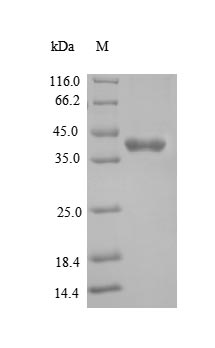Recombinant Mouse Tyrosine-protein kinase JAK1 (Jak1) is expressed in E. coli with an N-terminal 6xHis-tag that simplifies purification. This partial protein covers amino acids 848-1152 and shows purity levels above 90%, confirmed through SDS-PAGE analysis. Designed strictly for research purposes, this product offers scientists a useful tool for investigating kinase function and signaling pathways.
JAK1 appears to play a vital role in how various cytokines and growth factors communicate within cells. Being part of the Janus kinase family, JAK1 seems responsible for phosphorylating and activating STAT proteins—signal transducer and activator of transcription proteins that carry messages from cell surfaces to the nucleus. Understanding this protein may be essential for grasping how cells respond and regulate themselves, particularly in immune and blood-forming systems.
Potential Applications
Note: The applications listed below are based on what we know about this protein's biological functions, published research, and experience from experts in the field. However, we haven't fully tested all of these applications ourselves yet. We'd recommend running some preliminary tests first to make sure they work for your specific research goals.
Mouse JAK1 is a complex tyrosine kinase that requires precise folding, proper ATP-binding site formation, specific activation loop conformation, and regulatory phosphorylation for its enzymatic activity. The E. coli expression system cannot provide the eukaryotic folding environment or post-translational modifications (particularly activation loop phosphorylation) necessary for full kinase activity. The partial fragment (848-1152aa) represents the kinase domain but lacks critical N-terminal FERM and SH2 domains essential for proper regulation and substrate recognition. The N-terminal 6xHis-tag may sterically interfere with the protein's functional domains. While the kinase domain may be soluble, the probability of correct folding with functional kinase activity requires experimental validation.
1. In Vitro Kinase Activity Assays
This application carries a significant risk without functional validation. JAK1 kinase activity requires the precise formation of the ATP-binding site, proper activation loop conformation, and regulatory phosphorylation, which may be compromised in this expression system. If correctly folded and active (verified through autophosphorylation assays), the protein may be suitable for kinetic studies. If misfolded/inactive (unverified), kinase assays will yield biologically meaningless results.
2. JAK1-Specific Antibody Development and Validation
This application is highly suitable as antibody development relies on antigenic sequence recognition rather than functional kinase activity. The kinase domain fragment provides specific epitopes for generating antibodies against JAK1. The high purity (>90%) ensures minimal contamination-related issues during immunization protocols.
3. Protein-Protein Interaction Studies
This application requires proper folding validation. JAK1 interactions with substrates and regulatory proteins require precise tertiary structure. If correctly folded (verified), the protein may identify physiological interaction partners. If misfolded/unverified, there is a high risk of non-specific binding or failure to replicate genuine signaling complex formation.
4. Biophysical Characterization
These studies are essential for determining folding status. Techniques should include size-exclusion chromatography to assess oligomeric state, circular dichroism spectroscopy to evaluate secondary structure, and thermal shift assays to determine stability. However, the His-tag may interfere with high-resolution structural studies.
Final Recommendation & Action Plan
The E. coli expression system is fundamentally limited for producing a functionally active JAK1 kinase due to its inability to support proper eukaryotic folding and post-translational modifications. Begin with Application 4 (Biophysical Characterization) to assess folding quality through SEC, CD spectroscopy, and validate kinase activity through autophosphorylation assays before considering functional applications. Applications 1 and 3 require rigorous functional validation. Application 2 (antibody development) can proceed immediately. For reliable JAK1 research requiring native functionality, use a mammalian expression systems that support proper kinase folding, activation loop phosphorylation, and regulatory domain interactions.






